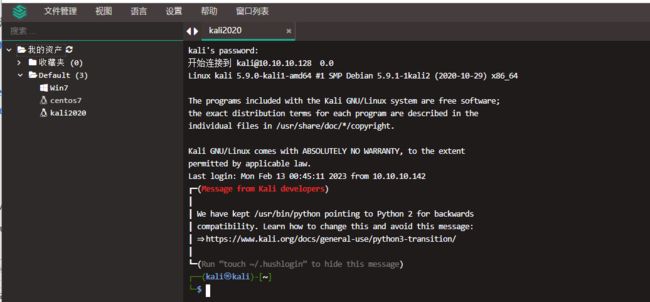- 网络安全工具 AWVS 与 Nmap:原理、使用及代码示例
阿贾克斯的黎明
网络安全安全web安全网络
目录网络安全工具AWVS与Nmap:原理、使用及代码示例AWVS:Web漏洞扫描的利器1.工具概述2.工作原理3.使用方法4.代码示例(Python调用AWVSAPI进行扫描)Nmap:网络探测与端口扫描的神器1.工具概述2.工作原理3.使用方法4.代码示例(Python调用Nmap进行扫描)总结在网络安全领域,AWVS(AcunetixWebVulnerabilityScanner)和Nmap是
- 深入剖析 Java 反序列化:FASTjson 漏洞与 Shiro 漏洞
阿贾克斯的黎明
网络安全phpweb安全开发语言
目录深入剖析Java反序列化:FASTjson漏洞与Shiro漏洞引言Java反序列化原理示例代码FASTjson漏洞分析漏洞成因示例代码防护措施Shiro漏洞分析漏洞成因示例代码(模拟攻击场景)防护措施总结引言在Java应用开发中,反序列化是一项重要的技术,但同时也隐藏着巨大的安全风险。FASTjson和Shiro作为Java开发中常用的工具和框架,其反序列化漏洞曾引发了广泛关注。本文将深入探讨
- 第14天:C++异常处理实战指南 - 构建安全的文件解析系统
JuicyActiveGilbert
C++教程c++安全开发语言
第14天:C++异常处理实战指南-构建安全的文件解析系统一、今日学习目标掌握C++异常处理的核心语法与流程️理解RAII在资源管理中的关键作用创建自定义文件解析异常体系实现安全的文件解析器原型二、C++异常处理核心机制1.异常处理基础语法#include#include#includevoidparseConfiguration(conststd::string&path){std::ifstre
- Composer如何通过GitHub Personal Access Token安装私有包:完整教程
lihuang319
composergithubphp
使用Composer安全管理您的PHP私有依赖包一、前言在PHP开发中,我们经常需要将内部工具包托管为私有仓库。传统的账号密码验证方式存在安全隐患,而GitHubPersonalAccessToken(PAT)提供了一种更安全的鉴权方案。本文将通过4个核心步骤+3个避坑指南,手把手教您在Composer中优雅地使用PAT安装私有包。二、为什么要用PAT?安全性:细粒度权限控制(可设置过期时间/单仓
- 硬盘数据恢复操作全攻略
AR新视野
本文还有配套的精品资源,点击获取简介:硬盘数据恢复是一项需要精确操作的技术活动,主要针对丢失、误删或损坏的文件进行恢复。本教程通过深入探讨数据恢复的基础知识和步骤,指导用户如何安全有效地执行数据恢复。教程强调了在硬盘故障发生时的正确处理方式,包括避免在受损硬盘上直接操作、使用保护卡或克隆技术复制数据,以及选择合适的数据恢复软件等。教程还提供了数据恢复的基本步骤,并告诫用户在数据非常关键或硬件问题复
- 网络安全加密python代码
黑客Ash
web安全安全
点击文末小卡片,免费获取网络安全全套资料,资料在手,涨薪更快网络信息安全中遇到的各种攻击是防不胜防的,采取适当的防护措施就能有效地保护网络信息的安全,包括防火墙、入侵检测系统、漏洞扫描技术以及加密技术等多种防护措施。而信息安全的本质就是要保护信息本身和信息系统在存储、传输中的完整性和保密性,保障不被攻击和篡改,上述的主动攻击、被动攻击和病毒袭击都会造成信息的破坏和泄密,我们以信息安全中的基础理论出
- 网络安全尹毅 《网络安全》
黑客Ash
web安全网络安全
点击文末小卡片,免费获取网络安全全套资料,资料在手,涨薪更快一网络安全基本概念1.网络安全定义安全在字典中的定义是为了防范间谍活动或蓄意破坏、犯罪、攻击而采取的措施。网络安全就是为了防范计算机网络硬件、软件、数据被偶然或蓄意破坏、篡改、窃听、假冒、泄露、非法访问以及保护网络系统持续有效工作的措施总和。网络安全保护范围:密码安全、计算机系统安全、网络安全、信息安全。2.网络安全目标可靠性(relia
- b s架构 网络安全 网络安全架构分析
黑客Ash
web安全架构网络
目录文章目录目录网络安全逻辑架构微分段(Micro-segmentation)防火墙即服务(FirewallasaService,FWaaS)安全网络网关(Securewebgateway)净化域名系统(SanitizedDomainNameSystem,S-DNS)网络安全策略管理(NetworkSecurityPolicyManagement,NSPM)网络防火墙(Networkfirewal
- IoT安全软件:Tenable二次开发_TenableIoT数据处理与分析
chenlz2007
物联网物联网自动化运维网络协议网络
TenableIoT数据处理与分析在上一节中,我们介绍了如何使用TenableIoT进行资产发现和漏洞扫描。接下来,我们将深入探讨如何处理和分析TenableIoT生成的数据,以便更好地理解网络中的安全态势,并采取适当的措施来保护我们的IoT设备。1.数据导出与格式转换在处理TenableIoT数据之前,首先需要将数据从TenableIoT平台导出,并转换为适合进一步分析的格式。TenableIo
- 什么是SSL?什么是TLS?SSL与TLS 区别
HOLD ON!
计算机网络
什么是SSL?什么是TLS?SSL与TLS区别chunqianpo7385一、什么是ssl?什么是tls?SSL:(SecureSocketLayer,安全套接字层),位于可靠的面向连接的网络层协议和应用层协议之间的一种协议层。SSL通过互相认证、使用数字签名确保完整性、使用加密确保私密性,以实现客户端和服务器之间的安全通讯。SSL协议可分为两层:SSL记录协议(SSLRecordProtocol
- 一个方法被多个线程同时调用,确保同样参数的调用只能有一个线程执行,不同参数的调用则可以多个线程同时执行
carcarrot
.Netlock同步锁相同参数同步锁
我们知道通过lock一个固定静态object给代码段加同步锁,可以让多个线程的同时调用以同步执行,因此可以利用字典来给不同参数分配不同的静态对象,方法中不同的参数调用锁住各自不同的静态对象即可实现不同参数不加锁,相同参数才加锁的需求,而多线程更新操作的字典需要用到线程安全的ConcurrentDictionary防止争用,因此这里的静态加锁对象字典类型为ConcurrentDictionary。比
- SSL 证书是 SSL 协议实现安全通信的必要组成部分
小丁学Java
计算机网络ssl安全网络协议
SSL证书和SSL/TLS协议有着密切的关系,但它们本质上是不同的概念。下面是两者的区别和它们之间的关系的表格:属性SSL/TLS协议SSL证书英文全称SSL(SecureSocketsLayer),TLS(TransportLayerSecurity)SecureSocketsLayerCertificate中文全称SSL(安全套接层协议)和TLS(传输层安全性协议)安全套接层证书定义SSL/T
- hnoi矿场搭建——Tarjan割点
stevensonson
BZOJ
Description煤矿工地可以看成是由隧道连接挖煤点组成的无向图。为安全起见,希望在工地发生事故时所有挖煤点的工人都能有一条出路逃到救援出口处。于是矿主决定在某些挖煤点设立救援出口,使得无论哪一个挖煤点坍塌之后,其他挖煤点的工人都有一条道路通向救援出口。请写一个程序,用来计算至少需要设置几个救援出口,以及不同最少救援出口的设置方案总数。Input输入文件有若干组数据,每组数据的第一行是一个正整
- 2025 MENC加密系统源码 V2.4.0
会说源码
数据库
MENC加密系统V2.4.0更新日志本次更新全面优化功能与性能,为您提供更加高效、安全的加密服务体验:此版本为无限加密授权版本,可修改数据库进行数据更改,功能正常使用,后门未详仅用于测试未对授权进行破解。1.新增SQL一键备份功能数据备份更高效,操作更便捷,显著提升管理体验。使用方法:访问站点域名/sql/backup?key=密钥,密钥可在系统目录根目录的.env文件中设置。备份文件默认存储在系
- 自学网络安全(黑客技术)2025年 —100天学习计划
白帽黑客cst
学习网络安全web安全linux
基于入门网络安全/黑客打造的:黑客&网络安全入门&进阶学习资源包前言什么是网络安全网络安全可以基于攻击和防御视角来分类,我们经常听到的“红队”、“渗透测试”等就是研究攻击技术,而“蓝队”、“安全运营”、“安全运维”则研究防御技术。如何成为一名黑客很多朋友在学习安全方面都会半路转行,因为不知如何去学,在这里,我将这个整份答案分为黑客(网络安全)入门必备、黑客(网络安全)职业指南、黑客(网络安全)学习
- 自学网络安全(黑客技术)2025年 —100天学习计划
白帽黑客cst
学习web安全安全网络linux
基于入门网络安全/黑客打造的:黑客&网络安全入门&进阶学习资源包前言什么是网络安全网络安全可以基于攻击和防御视角来分类,我们经常听到的“红队”、“渗透测试”等就是研究攻击技术,而“蓝队”、“安全运营”、“安全运维”则研究防御技术。如何成为一名黑客很多朋友在学习安全方面都会半路转行,因为不知如何去学,在这里,我将这个整份答案分为黑客(网络安全)入门必备、黑客(网络安全)职业指南、黑客(网络安全)学习
- 自学网络安全(黑客技术)2025年 —100天学习计划
白帽黑客cst
学习web安全安全网络linux
基于入门网络安全/黑客打造的:黑客&网络安全入门&进阶学习资源包前言什么是网络安全网络安全可以基于攻击和防御视角来分类,我们经常听到的“红队”、“渗透测试”等就是研究攻击技术,而“蓝队”、“安全运营”、“安全运维”则研究防御技术。如何成为一名黑客很多朋友在学习安全方面都会半路转行,因为不知如何去学,在这里,我将这个整份答案分为黑客(网络安全)入门必备、黑客(网络安全)职业指南、黑客(网络安全)学习
- 网络安全(黑客技术) 最新—90天学习计划
白帽黑客cst
网络安全web安全网络安全学习数据结构mysql
基于入门网络安全/黑客打造的:黑客&网络安全入门&进阶学习资源包前言什么是网络安全网络安全可以基于攻击和防御视角来分类,我们经常听到的“红队”、“渗透测试”等就是研究攻击技术,而“蓝队”、“安全运营”、“安全运维”则研究防御技术。如何成为一名黑客很多朋友在学习安全方面都会半路转行,因为不知如何去学,在这里,我将这个整份答案分为黑客(网络安全)入门必备、黑客(网络安全)职业指南、黑客(网络安全)学习
- 自学网络安全(黑客技术)2024年 —100天学习计划
白帽黑客cst
学习web安全安全网络linux
基于入门网络安全/黑客打造的:黑客&网络安全入门&进阶学习资源包前言什么是网络安全网络安全可以基于攻击和防御视角来分类,我们经常听到的“红队”、“渗透测试”等就是研究攻击技术,而“蓝队”、“安全运营”、“安全运维”则研究防御技术。如何成为一名黑客很多朋友在学习安全方面都会半路转行,因为不知如何去学,在这里,我将这个整份答案分为黑客(网络安全)入门必备、黑客(网络安全)职业指南、黑客(网络安全)学习
- Redis安全漏洞
清扬叶
redis后端
Redis安全漏洞Redis默认情况下,会绑定在0.0.0.0:6379,如果没有进行采用相关的策略,比如添加防火墙规则避免其他非信任来源ip访问等,这样将会将Redis服务暴露到公网上,如果在没有设置密码认证(一般为空)的情况下,会导致任意用户在可以访问目标服务器的情况下未授权访问Redis以及读取Redis的数据。攻击者在未授权访问Redis的情况下,利用Redis自身的提供的config命令
- mPaas-RPC拦截器各种场景下的使用指南
阿里开发者
移动开发运维JavaScriptJava
简介:mPaas-RPC拦截器各种场景下的使用指南1.背景金融级移动开发平台mPaaS[1](MobilePaaS)为App开发、测试、运营及运维提供云到端的一站式解决方案,能有效降低技术门槛、减少研发成本、提升开发效率,协助企业快速搭建稳定高质量的移动应用。其中移动网关服务(MobileGatewayService,简称MGS)作为mPaas最重要的组件之一,连接了移动客户端与服务端,简化了移动
- 动态规划之线性DP-安全序列
小丽今天学代码了吗
动态规划算法
问题描述小蓝是工厂里的安全工程师,他负责安放工厂里的危险品。工厂是一条直线,直线上有n个空位,小蓝需要将若干个油桶放置在n个空位上,每2个油桶中间至少需要k个空位隔开,现在小蓝想知道有多少种放置油桶的方案,你可以编写一个程序帮助他吗?由于这个结果很大,你的输出结果需要对取模。输入格式第一行包含两个正整数n,k,分别表示n个空位与k个隔开的空位。输出格式输出共1行,包含1个整数,表示放置的方案数对取
- 分享---rpc运维事故处理
XiaoDuofCSDN
rpc运维网络协议
事故案例03-QserverRPC调用大量失败一、事故背景Queryserver是内部的核心服务,负责处理数据查询请求并支持分布式缓存功能。为优化缓存一致性,新增了分布式锁逻辑:在查询请求命中缓存时需先获取分布式锁(基于Tair实现),若未获取成功则等待1秒后重试。此功能上线后,在特定异常场景下(如SQL执行失败)触发了线程池资源耗尽,最终导致RPC请求被拒绝,引发服务故障。二、事故影响(一)业务
- 人工智能算法安全优化实践路径
智能计算研究中心
其他
内容概要在人工智能技术深度融入产业实践的进程中,算法安全优化已成为保障系统可靠性与社会信任的核心命题。本文系统性梳理从数据预处理到模型落地的全流程安全实践路径,聚焦金融风控、医疗影像诊断、自动驾驶等关键场景,揭示算法开发中潜藏的伦理风险与技术挑战。通过整合自动化机器学习与联邦学习技术,构建跨数据孤岛的协作框架,同时引入可解释性算法增强模型透明度,确保决策逻辑可追溯、可验证。在模型优化维度,重点解析
- 金融风控与医疗影像算法创新前沿
智能计算研究中心
其他
内容概要在金融风控与医疗影像交叉领域,算法创新正推动两大行业的技术范式变革。联邦学习算法通过分布式数据协作机制,在保证隐私安全的前提下,显著提升金融风险预测模型的泛化能力。医疗影像诊断领域则依托三维卷积神经网络(3D-CNN)架构,实现了对CT、MRI等多模态影像的精准病灶分割,诊断准确率较传统方法提升23.6%。值得关注的是,可解释性算法(如LIME和SHAP)的深度应用,使两类场景中的模型决策
- Python 并发编程:线程详解
风因絮
Python进阶知识python开发语言
在Python中,默认每个Python文件会创建一个进程,用于提供运行资源和环境。进程启动后,会创建一个主线程,用于执行程序代码。线程是并发编程的核心之一,本文将详细解析Python中线程的基础概念、常见操作、线程安全以及线程池的使用。一、线程基础1.什么是线程?线程是计算机中可以被CPU调度的最小单位。每个线程在程序中独立运行,多个线程可以并发执行。在Python中,线程由threading模块
- DeepSeek本地部署必要性分析及云端替代方案推荐
Asher_Yao
人工智能
一、本地部署适用场景分析硬件要求完整版模型需≥32GB显存(推荐NVIDIAA100/A800)基础版也需RTX3090级别显卡(约150W功耗)适用人群建议✔️企业用户:需私有化部署处理敏感数据✔️研究人员:需定制模型微调✔️开发者:需API深度集成维护成本单节点年运维成本≈¥18,000(含电费/散热)二、已验证的云端替代方案(2025.2实测)方案1:硅基流动SaaS平台技术特性:支持API
- 【Python百日进阶-Web开发-FastAPI】Day801 - FastAPI是什么
岳涛@泰山医院
Dashpython前端fastapi
文章目录一、官网二、FastAPI是什么三、FastAPI特性3.1基于开放标准3.2自动生成文档3.3更主流的Python3.4编辑器支持3.5简洁3.6验证3.7安全性及身份验证¶3.8依赖注入3.9无限制"插件"3.10测试四、Starlette特性五、Pydantic特性六、Python类型提示简介6.1动机6.1.1简单示例6.1.2修改示例6.1.3添加类型6.2更多动机6.3声明类型
- Python自动化运维实战,怎么构建分布式质量监控平台
好知识传播者
Python实例开发实战运维python自动化分布式质量监控平台linux
注意:本文的下载教程,与以下文章的思路有相同点,也有不同点,最终目标只是让读者从多维度去熟练掌握本知识点。下载教程:Python自动化运维项目开发实战_构建分布式质量监控平台_编程案例解析实例课程教程.pdf一、引言随着企业业务的不断扩展和复杂化,系统运维面临着越来越多的挑战。传统的运维方式已经无法满足现代企业的需求,因此,自动化运维成为了企业提升运维效率、保障系统稳定性的重要手段。在自动化运维中
- 对象存储
Mini' miss
pythonjavac#phpc++
对象存储(CloudObjectStorage,COS)是腾讯云提供的一种存储海量文件的分布式存储服务,具有高扩展性、低成本、可靠安全等优点。通过控制台、API、SDK和工具等多样化方式,用户可简单、快速地接入COS,进行多格式文件的上传、下载和管理,实现海量数据存储和管理。产品概述本页目录:对象存储(CloudObjectStorage,COS)是腾讯云提供的一种存储海量文件的分布式存储服务,用
- mondb入手
木zi_鸣
mongodb
windows 启动mongodb 编写bat文件,
mongod --dbpath D:\software\MongoDBDATA
mongod --help 查询各种配置
配置在mongob
打开批处理,即可启动,27017原生端口,shell操作监控端口 扩展28017,web端操作端口
启动配置文件配置,
数据更灵活
- 大型高并发高负载网站的系统架构
bijian1013
高并发负载均衡
扩展Web应用程序
一.概念
简单的来说,如果一个系统可扩展,那么你可以通过扩展来提供系统的性能。这代表着系统能够容纳更高的负载、更大的数据集,并且系统是可维护的。扩展和语言、某项具体的技术都是无关的。扩展可以分为两种:
1.
- DISPLAY变量和xhost(原创)
czmmiao
display
DISPLAY
在Linux/Unix类操作系统上, DISPLAY用来设置将图形显示到何处. 直接登陆图形界面或者登陆命令行界面后使用startx启动图形, DISPLAY环境变量将自动设置为:0:0, 此时可以打开终端, 输出图形程序的名称(比如xclock)来启动程序, 图形将显示在本地窗口上, 在终端上输入printenv查看当前环境变量, 输出结果中有如下内容:DISPLAY=:0.0
- 获取B/S客户端IP
周凡杨
java编程jspWeb浏览器
最近想写个B/S架构的聊天系统,因为以前做过C/S架构的QQ聊天系统,所以对于Socket通信编程只是一个巩固。对于C/S架构的聊天系统,由于存在客户端Java应用,所以直接在代码中获取客户端的IP,应用的方法为:
String ip = InetAddress.getLocalHost().getHostAddress();
然而对于WEB
- 浅谈类和对象
朱辉辉33
编程
类是对一类事物的总称,对象是描述一个物体的特征,类是对象的抽象。简单来说,类是抽象的,不占用内存,对象是具体的,
占用存储空间。
类是由属性和方法构成的,基本格式是public class 类名{
//定义属性
private/public 数据类型 属性名;
//定义方法
publ
- android activity与viewpager+fragment的生命周期问题
肆无忌惮_
viewpager
有一个Activity里面是ViewPager,ViewPager里面放了两个Fragment。
第一次进入这个Activity。开启了服务,并在onResume方法中绑定服务后,对Service进行了一定的初始化,其中调用了Fragment中的一个属性。
super.onResume();
bindService(intent, conn, BIND_AUTO_CREATE);
- base64Encode对图片进行编码
843977358
base64图片encoder
/**
* 对图片进行base64encoder编码
*
* @author mrZhang
* @param path
* @return
*/
public static String encodeImage(String path) {
BASE64Encoder encoder = null;
byte[] b = null;
I
- Request Header简介
aigo
servlet
当一个客户端(通常是浏览器)向Web服务器发送一个请求是,它要发送一个请求的命令行,一般是GET或POST命令,当发送POST命令时,它还必须向服务器发送一个叫“Content-Length”的请求头(Request Header) 用以指明请求数据的长度,除了Content-Length之外,它还可以向服务器发送其它一些Headers,如:
- HttpClient4.3 创建SSL协议的HttpClient对象
alleni123
httpclient爬虫ssl
public class HttpClientUtils
{
public static CloseableHttpClient createSSLClientDefault(CookieStore cookies){
SSLContext sslContext=null;
try
{
sslContext=new SSLContextBuilder().l
- java取反 -右移-左移-无符号右移的探讨
百合不是茶
位运算符 位移
取反:
在二进制中第一位,1表示符数,0表示正数
byte a = -1;
原码:10000001
反码:11111110
补码:11111111
//异或: 00000000
byte b = -2;
原码:10000010
反码:11111101
补码:11111110
//异或: 00000001
- java多线程join的作用与用法
bijian1013
java多线程
对于JAVA的join,JDK 是这样说的:join public final void join (long millis )throws InterruptedException Waits at most millis milliseconds for this thread to die. A timeout of 0 means t
- Java发送http请求(get 与post方法请求)
bijian1013
javaspring
PostRequest.java
package com.bijian.study;
import java.io.BufferedReader;
import java.io.DataOutputStream;
import java.io.IOException;
import java.io.InputStreamReader;
import java.net.HttpURL
- 【Struts2二】struts.xml中package下的action配置项默认值
bit1129
struts.xml
在第一部份,定义了struts.xml文件,如下所示:
<!DOCTYPE struts PUBLIC
"-//Apache Software Foundation//DTD Struts Configuration 2.3//EN"
"http://struts.apache.org/dtds/struts
- 【Kafka十三】Kafka Simple Consumer
bit1129
simple
代码中关于Host和Port是割裂开的,这会导致单机环境下的伪分布式Kafka集群环境下,这个例子没法运行。
实际情况是需要将host和port绑定到一起,
package kafka.examples.lowlevel;
import kafka.api.FetchRequest;
import kafka.api.FetchRequestBuilder;
impo
- nodejs学习api
ronin47
nodejs api
NodeJS基础 什么是NodeJS
JS是脚本语言,脚本语言都需要一个解析器才能运行。对于写在HTML页面里的JS,浏览器充当了解析器的角色。而对于需要独立运行的JS,NodeJS就是一个解析器。
每一种解析器都是一个运行环境,不但允许JS定义各种数据结构,进行各种计算,还允许JS使用运行环境提供的内置对象和方法做一些事情。例如运行在浏览器中的JS的用途是操作DOM,浏览器就提供了docum
- java-64.寻找第N个丑数
bylijinnan
java
public class UglyNumber {
/**
* 64.查找第N个丑数
具体思路可参考 [url] http://zhedahht.blog.163.com/blog/static/2541117420094245366965/[/url]
*
题目:我们把只包含因子
2、3和5的数称作丑数(Ugly Number)。例如6、8都是丑数,但14
- 二维数组(矩阵)对角线输出
bylijinnan
二维数组
/**
二维数组 对角线输出 两个方向
例如对于数组:
{ 1, 2, 3, 4 },
{ 5, 6, 7, 8 },
{ 9, 10, 11, 12 },
{ 13, 14, 15, 16 },
slash方向输出:
1
5 2
9 6 3
13 10 7 4
14 11 8
15 12
16
backslash输出:
4
3
- [JWFD开源工作流设计]工作流跳跃模式开发关键点(今日更新)
comsci
工作流
既然是做开源软件的,我们的宗旨就是给大家分享设计和代码,那么现在我就用很简单扼要的语言来透露这个跳跃模式的设计原理
大家如果用过JWFD的ARC-自动运行控制器,或者看过代码,应该知道在ARC算法模块中有一个函数叫做SAN(),这个函数就是ARC的核心控制器,要实现跳跃模式,在SAN函数中一定要对LN链表数据结构进行操作,首先写一段代码,把
- redis常见使用
cuityang
redis常见使用
redis 通常被认为是一个数据结构服务器,主要是因为其有着丰富的数据结构 strings、map、 list、sets、 sorted sets
引入jar包 jedis-2.1.0.jar (本文下方提供下载)
package redistest;
import redis.clients.jedis.Jedis;
public class Listtest
- 配置多个redis
dalan_123
redis
配置多个redis客户端
<?xml version="1.0" encoding="UTF-8"?><beans xmlns="http://www.springframework.org/schema/beans" xmlns:xsi=&quo
- attrib命令
dcj3sjt126com
attr
attrib指令用于修改文件的属性.文件的常见属性有:只读.存档.隐藏和系统.
只读属性是指文件只可以做读的操作.不能对文件进行写的操作.就是文件的写保护.
存档属性是用来标记文件改动的.即在上一次备份后文件有所改动.一些备份软件在备份的时候会只去备份带有存档属性的文件.
- Yii使用公共函数
dcj3sjt126com
yii
在网站项目中,没必要把公用的函数写成一个工具类,有时候面向过程其实更方便。 在入口文件index.php里添加 require_once('protected/function.php'); 即可对其引用,成为公用的函数集合。 function.php如下:
<?php /** * This is the shortcut to D
- linux 系统资源的查看(free、uname、uptime、netstat)
eksliang
netstatlinux unamelinux uptimelinux free
linux 系统资源的查看
转载请出自出处:http://eksliang.iteye.com/blog/2167081
http://eksliang.iteye.com 一、free查看内存的使用情况
语法如下:
free [-b][-k][-m][-g] [-t]
参数含义
-b:直接输入free时,显示的单位是kb我们可以使用b(bytes),m
- JAVA的位操作符
greemranqq
位运算JAVA位移<<>>>
最近几种进制,加上各种位操作符,发现都比较模糊,不能完全掌握,这里就再熟悉熟悉。
1.按位操作符 :
按位操作符是用来操作基本数据类型中的单个bit,即二进制位,会对两个参数执行布尔代数运算,获得结果。
与(&)运算:
1&1 = 1, 1&0 = 0, 0&0 &
- Web前段学习网站
ihuning
Web
Web前段学习网站
菜鸟学习:http://www.w3cschool.cc/
JQuery中文网:http://www.jquerycn.cn/
内存溢出:http://outofmemory.cn/#csdn.blog
http://www.icoolxue.com/
http://www.jikexue
- 强强联合:FluxBB 作者加盟 Flarum
justjavac
r
原文:FluxBB Joins Forces With Flarum作者:Toby Zerner译文:强强联合:FluxBB 作者加盟 Flarum译者:justjavac
FluxBB 是一个快速、轻量级论坛软件,它的开发者是一名德国的 PHP 天才 Franz Liedke。FluxBB 的下一个版本(2.0)将被完全重写,并已经开发了一段时间。FluxBB 看起来非常有前途的,
- java统计在线人数(session存储信息的)
macroli
javaWeb
这篇日志是我写的第三次了 前两次都发布失败!郁闷极了!
由于在web开发中常常用到这一部分所以在此记录一下,呵呵,就到备忘录了!
我对于登录信息时使用session存储的,所以我这里是通过实现HttpSessionAttributeListener这个接口完成的。
1、实现接口类,在web.xml文件中配置监听类,从而可以使该类完成其工作。
public class Ses
- bootstrp carousel初体验 快速构建图片播放
qiaolevip
每天进步一点点学习永无止境bootstrap纵观千象
img{
border: 1px solid white;
box-shadow: 2px 2px 12px #333;
_width: expression(this.width > 600 ? "600px" : this.width + "px");
_height: expression(this.width &
- SparkSQL读取HBase数据,通过自定义外部数据源
superlxw1234
sparksparksqlsparksql读取hbasesparksql外部数据源
关键字:SparkSQL读取HBase、SparkSQL自定义外部数据源
前面文章介绍了SparSQL通过Hive操作HBase表。
SparkSQL从1.2开始支持自定义外部数据源(External DataSource),这样就可以通过API接口来实现自己的外部数据源。这里基于Spark1.4.0,简单介绍SparkSQL自定义外部数据源,访
- Spring Boot 1.3.0.M1发布
wiselyman
spring boot
Spring Boot 1.3.0.M1于6.12日发布,现在可以从Spring milestone repository下载。这个版本是基于Spring Framework 4.2.0.RC1,并在Spring Boot 1.2之上提供了大量的新特性improvements and new features。主要包含以下:
1.提供一个新的sprin





